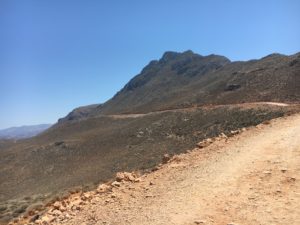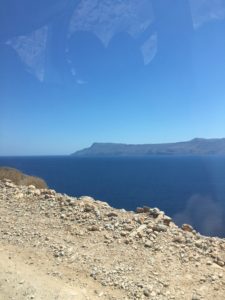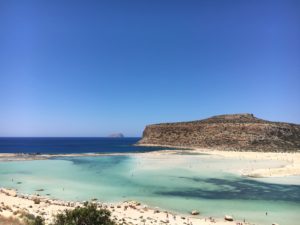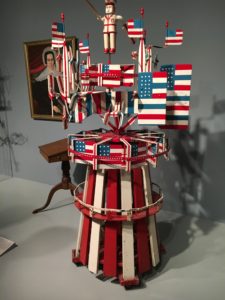Having faith is a pretty common term among we humans. But do we really know and appreciate what it means, and how does it interact with facts? We could say that Science is fact, and for instance, believing in Jesus is faith. Or you could say “I am going to the shop today to drop my car off,” is fact. And “One of my teenagers is going to pick me up and give me a ride home,” is faith. Speaking of that, I know factually that I have three daughters. I don’t know with a 100% certainty that they’re going to be “Okay” in every sense of that word 5 years from now, 10 years from now or even 15 years from now. That is where faith takes over. Recently two of my daughters and I had the privilege of spending several days on the island of Crete, Greece. On one of those days, we traveled to the Balos Lagoon-a must see on our Crete bucket list. However, the journey to that beautiful place was fraught with peril. Initially we drove along a nice asphalt highway, then exited on to a smaller but still easily navigable road through a couple of villages. Eventually we moved to a little more bumpy surface, still not clenching our teeth in fear, which brought us to the gate where we paid a national park fee to continue to the Lagoon. Oh but our drive had only just begun. Up to this point, I felt the road trip was easily traversed. But soon we found we were negotiating a very difficult road that would have been better traveled in an “off-road” vehicle not our little rental Fiat Diablo. Now it was white knuckled driving, wondering if we made the right decision to venture forward off the “main” roads. The first part of our trip to the Lagoon was cushioned with facts. The last of our drive to the lagoon was negotiated only by faith. Faith that we would not blow a tire on this mountain range of sharp pointy white rock; faith that we would not go tumbling over the side of the mountain several hundred feet down-a sheer drop to the rocky shores of the Mediterranean; faith that we would arrive successfully at our destination and in one piece. 


Monthly Archives: August 2016
The Marriage of Immigration and Citizenship: America’s Sore Spot
A couple of weeks ago my youngest daughter Katie and I were going through a wonderful museum in Chicago: The American Art Institute. I highly recommend it to anyone who finds themselves in the windy city. It is such a gift to have museums right here in the states which boast so many wonderful works of art, both American and European, all in one place. This particular exhibit from the American Folk Art section of the museum, really captured our attention. It’s a whirligig.

Yes, that’s right a whirligig. I love the whirligig, and not just because I like to say the word. Apparently whirligigs were used for a number of things-scarecrows, weather vanes to name a few. But the most significant fact about this whirligig is its creator and the inspiration of the creator. This whirligig aptly titled “America,” was made by Frank Memkus, a Lithuanian immigrant to the United States of America during the 19th century. On the placard right next to this exhibit, it states the artist’s clear purpose: “This early 20th century example (of a whirligig) is both whimsical and utilitarian, made to honor this country in a gesture of pride and patriotism.” Wow! Being an American patriot myself, obviously I love the way this whirligig bleeds red, white and blue. And I love the story behind the artist and his creation.
Anyone who knows anything at all about American history, knows that with the one exception of Native Americans, ALL of us come from somewhere besides here. Most of us are of European descent. My maiden name is English. My married name is either Irish or Scottish (the jury is out on this). I have friends galore with German last names and those with Italian last names, all English-speaking born and bred Americans. Our country was first settled in the 17th century by those who came from England (by way of Holland) seeking their independence and escaping the tyranny of a Monarchy. Read up on Ellis Island. Or better yet, pay the island a visit. Millions of immigrants came through Ellis Island in the early 20th century, not looking for a handout, but looking for a place to hon and market their craft. They were looking for a place to live life, to grow and to have their families. Unwittingly, in the process of seeking a better life for themselves, they built up a country. I love studying Texas history. For one thing, I live in Texas. But the story of Texas’ independence is absolutely fascinating. In 1824 we Americans were immigrants to Texas, encouraged (and invited) by the government of Mexico to settle the land. In addition to Americans from the bordering union states moving to Texas, were also thousands of German Americans. When this hodgepodge of American citizens became seriously oppressed and abused by the Mexican government, they fought together, died together, and inevitably, won their independence from Mexico. They became the “Republic of Texas” until they were annexed to the USA in 1846.
The common denominator between Frank Memkus, 17th century pilgrims, 20th century European immigrants, and 19th century Texans is this: they were all immigrants working toward a common goal. That common goal included a common language, and a common purpose: freedom. Therein lies the sore spot for Americans today. Are immigrants in this country still coming here to live, work, improve their lives and to contribute to the lives of those around them? Is their purpose like Frank Memkus, to hon their craft and to boast pride and patriotism in the country that has afforded them such an opportunity? Many are indeed. But still many are not. And therein lies the chasm between voting Americans who have clashing views on immigration.
Today there are hundreds, perhaps thousands of immigrants who fly the flag of their native country in their front yards, but not the American flag. There are also immigrants who want the abusive legal framework of their country to be applicable here in America. And then there is the language issue. I think it is an atrocity that American Schools do not focus on foreign languages the way European countries do. If we are to remain a global power economically (and otherwise,) we need to better address the foreign language requirements in public schools. But I also think that every person who lives and works in this country and wants to immigrate to this country to live the life of freedom that characterizes America, should know how to speak its language, English. It is the one single thing that binds us all together. What makes us American? Diversity? Absolutely! But that diversity demands a common bond that glues us together in peace time and in war. That common bond from the beginning of our formation was our language. And after that, our flag: old red, white and blue. The two represent ALL of us,: everyone that came over on the Speedwell and the Mayflower. Our language and our flag include everyone that walked through the doors at Ellis Island. Our language and our flag include every Texan that died at the Alamo. Our language and our flag include every soldier, North and South, who died in that bloody American Civil War. Like other American states who proudly don their state flags, in Texas we proudly fly the Lone Star Flag of Texas along with the American Flag. What I don’t see is the “Republic of Texas” flag? Why? Because in 1846 Texas became part of this great country, the United States of America. That’s why I think it is so sad when I see people flying the Confederate flag. It minimizes and debases The American flag. It minimizes and devalues all who died in the civil war. The American flag is what our ancestors, friends, and relatives have died for. I don’t care what war it was. And that’s why I am equally sad when I see an American immigrant today from any country, flying his native flag in his front yard either above or in lieu of the American flag.
But really what is this blog about? It’s about trying to shine a bit of light on both sides of the issue. Those who think we should block immigration all together have forgotten they themselves are an immigrant. And it is for those on the other side of the issue who have forgotten what binds us all together, our flag and our language. Both are paramount in bringing us together as a country whether it’s in the arena of public policy or the public park. Ironically, both sides have forgotten about Frank Memkus. If it weren’t for the Frank Memkuses of yesterday, this country would be a fraction of what it is today. Frank Memkus came here like so many hundreds of thousands of other immigrants grateful for what this country offered him, a chance. And a place to have life, liberty and the pursuit of happiness. His whirligig is a resounding and thunderous message of his gratitude and his heartfelt thank you. That was and still is the American dream.